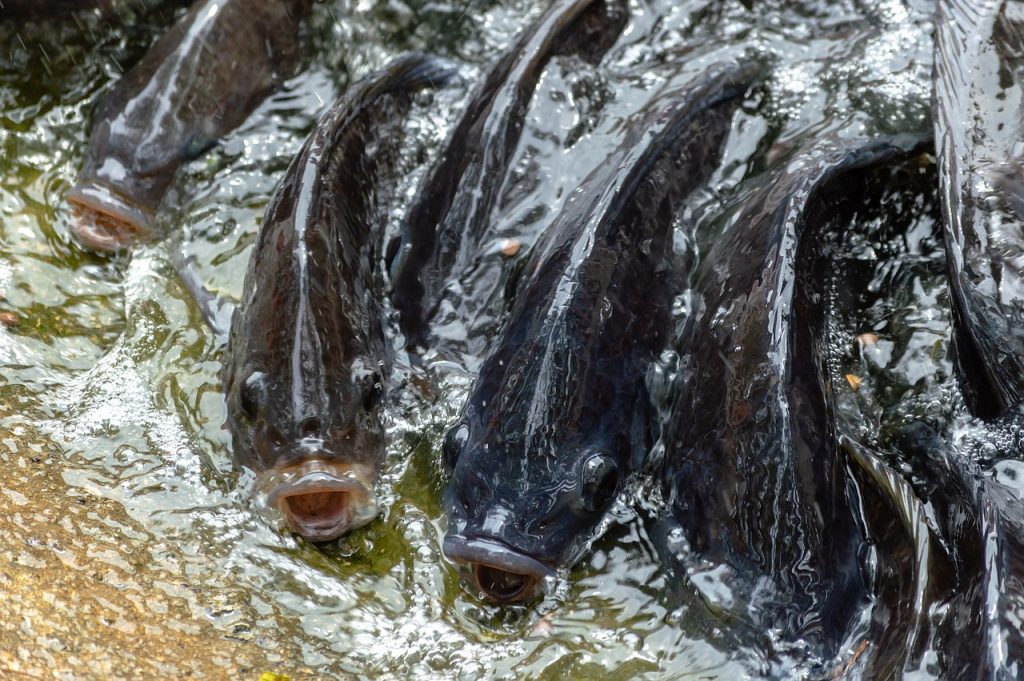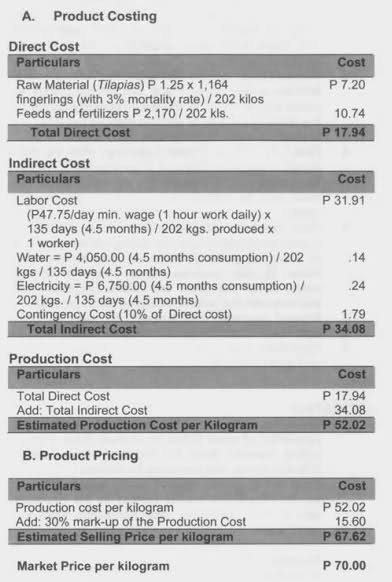Tilapia is the second most important freshwater food in the Philippines. The most important species is the Nile Tilapia (Tilapia Nolitica). Tilpia grows very fast and reaches marketable weight of at least 200 grams in less than six months. A backyard fishpond for tilapia will increase family income because it is a good quality food suitable for processing into dried, smoked, or salted dried.

I. Estimated Investment Cost
II. Procedure
Fishpond Selection and Preparation
1. Select Fishpond with the following characteristics:
– Clay soil to hold water
– Water is accessible throughout the year and can be sourced from river, spring, deep-well, rain or tap water. It must be free from pesticide contamination and pollution.
– Site is elevated for water to flow easily.
– Pond size could be 30-200 sqm. initially and can be expanded.
– Should not be flooded during the rainy season and has enough sunlight.
2. Level the bottom of the pond to prevent seepage.
3. Conduct pond treatment only in concrete ponds to remove the toxic effect of cement. Do this by washing, flooding, and draining the pond at least three (3) times.
4. Fertilize with organic fertilizer (chicken manure) at a rate of 1kg/sqm.
5. Fill the pond with water at an initial depth of 5-10 cm after the application of organic fertilizer for a week. This would allow the growing of algae to serve as natural feed for the fish. Growth can be observed through the greenish coloration of water.
6. Fill the pond with water to the desired level between 1m to 1.5 m
7. To ensure no fish will escape, fine-meshed wire should screen the drainage area (pipe).
Stocking
1. Stock during the early morning or late in the afternoon when the water is cool to avoid the weakening of the fish. Care should be maintained. Choose pure quality stocks and do not allow them to crossbreed with other species to preserve their genetic quality.
2. Deliver the fingerlings to the pond in oxygenated plastic bags to ensure maximum survival of the fingerlings.
3. To assimilate water in plastic bags, open the plastic bags of fingerlings to float within the pond from 30 minutes to one hour. Open the plastic bags in water to allow the fingerlings to swim freely.
4. Stock the ponds of at least 6 fingerlings/sqm. The ratio is 1 male is to 3 females. Avoid to pair many male tilapias because this tends to slow down the production of fingerlings since they tend to eat their own fingerlings due to lack of feed.
Care and Maintenance
1. Feed the tilapias twice daily (morning and afternoon) in one portion of the pond. Supplement feeds with fine rice bran, bread crumbs, earthworms and others at an initial rate of 5% of the total body weight of the fish.
2. Maintain the natural fishfood by adding more fertilizer every week. Place chicken droppings in sacks and suspend in the water at every corner of the pond. Put 2.5 kg of chicken manure per bag.
3. Maintain a water depth level of 1- 1.5 meters.
4. Gradually remove excess fingerlings after the third month of stocking. Retain 6 fingerlings/sqm. Excess fingerlings can be used in the manufacture of fish meal and as ingredient for livestock and poultry needs.
5. Plant kangkong and gabi at one portion of the pond to provide shade for the fish during hot weather and to serve as growing media for natural fish food. Water lily also provides shade. However, do not totally cover the pond with plants as these will interfere with the natural food production process.
6. Prevent seepages and leakages by patching them with muds. Clear the pond dikes with weeds.
7. Plant trees and grass near the dike to avoid erosion and avoid dumping of garbage.
Harvesting
1. Introduce catfish to pond to control the population of small fishes for at least three months before harvest. After 4-6 months, tilapias weigh 200-400 grams and are ready for harvest.
2. Drain the pond totally and allow fish to accommodate the lowest portion in the drainage area for easy harvesting. After harvesting stock the pond again.
Sources on procedures:
Sustainable Livelihood Options for the Philippines- An Information kit (Coastal Ecosystem). Department of Environment and Natural Resources (DENR).
III. Estimated Costing and Pricing (For 1 Kg of Tilapia)
* Estimated pricing and costing is based on a 100 sqm. concrete pond.
* Tilapia weigh at an average of 200-250 grams and are sold at 4-5 pieces for every kilo.
* The higher the volume (and larger the pond area) of production per season (more than 202 kgs.), the lower the production cost, thus further increasing the mark-up to more than 30%. The higher the mark-up, the more profits earned.
* If price per kilogram is lower compared with existing market price, increase the mark-up to more than 30%.
IV. Registration Requirements
1. Business Name registration- DTI
2. Mayor’s Permit/ Residence Certificate and Sanitary Permit
3. Tax Identification Number- BIR
Source: dti.gov.ph
To all REGION12 including nearby Regions of Mindanao, Meron po akong truck na pwede arkilahin para sa mga isda nyo na ipapadeliver or kung ano na pwede nyo ipadeliver, kung sino man ang may fisdpond dyan pwede ko iharvest at may buyer nadin. Usap tayo.
Contact number- 09165868804
Ms Marimar Arcena
Hi im joselito de asis looking for any one that provides me business plan for tilapia ang bangus.
are these costing numbers and sale number that you procided still accurate as of April 2018?
if not what has changed?
Hi!
Thanks for sharing your knowledge.
Ang tanong ko po,puwede bang gamitin ang tubig galing sa reject ng water refilling station para sa pag-aalaga ng tilapia?
Hi,
i am Alphonce Lyamuya from Tanzania,i like your articles concerning with tilapia fish pond,i intend to establish my own tilapia fish farm in this year.Stay blessed.